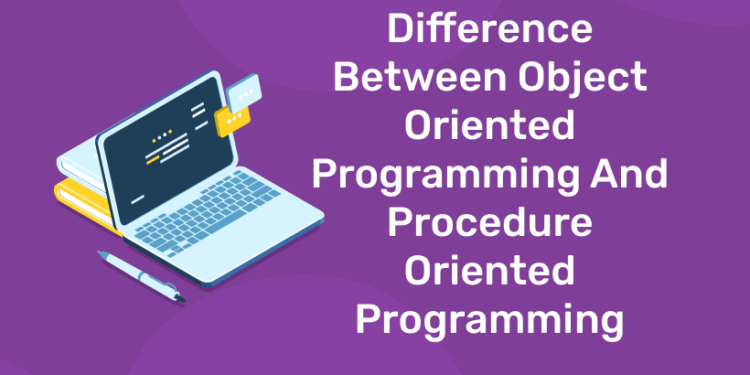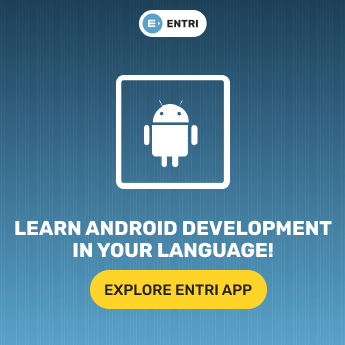Table of Contents
Object oriented programming is defined as a programming model which is based upon the concept of objects. Objects contain data in the form of attributes and code in the form of methods. In object oriented programming, computer programs are designed using the concept of objects that interact with real world.
Comparison Table Between Object-Oriented Programming and Procedural Programming
| Parameters of Comparison | Object-Oriented Programming | Procedural Programming |
|---|---|---|
| Approach | Bottom-up approach | Top-down approach |
| Divided into | Objects | Functions |
| Secure | More | Less |
| Access specifier | Yes | No |
| Examples | C++ and JAVA | BASIC and FORTRAN |
Grab the opportunity to learn Java with Entri! Click Here
Difference Between Procedural and Object Oriented Programming
1: Which of the following data structures allows elements to be added and removed in a Last-In, First-Out (LIFO) order?
| Parameter | Procedural Programming | Object Oriented Programming |
| Definition | This programming language makes use of a step by step approach for breaking down a task into a collection of routines (or subroutines) and variables by following a sequence of instructions. It carries out each step systematically in order so that a computer easily gets to understand what to do. | This programming language uses objects and classes for creating models based on the real-world environment. This model makes it very easy for a user to modify as well as maintain the existing code while new objects get created by inheriting the characteristics of the present ones. |
| Security | Procedural Programming does not offer any method of hiding data. Thus, it is less secure when compared to Object Oriented Programming. | Hiding data is possible with Object Oriented Programming due to the abstraction. Thus, it is more secure than the Procedural Programming. |
| Method | The main program gets divided into minute parts on the basis of the functions. It then treats them as separate programs for smaller programs individually. | It involves the concept of classes and objects. Hence, it divides the program into minute chunks known as objects. These are actually instances of classes. |
| Division of Program | Procedural Programming divides the program into small programs and refers to them as functions. | Object Oriented Programming divides the program into small parts and refers to them as objects. |
| Movement of Data | Available data is capable of moving freely within the system from one function to another. | The objects are capable of moving and communicating with each other through the member functions. |
| Approach | The Procedural Programming follows a Top-Down approach. | The Object Oriented Programming follows a Bottom-Up approach. |
| Importance | This programming model does not give importance to data. It prioritizes the functions along with the sequence of actions that needs to follow. | This programming model gives importance to the data rather than functions or procedures. It is because it works on the basis of the real world. |
| Orientation | It is Structure/Procedure oriented. | It is Object Oriented. |
| Basis | The main focus in Procedural Programming is on how to do the task, meaning, on the structure or procedure of the program. | The main focus in Object Oriented Programming is on data security. Hence, it only permits objects to access the class entities. |
| Type of Division | It divides any large program into small units called functions. | It divides the entire program into small units called objects. |
| Inheritance | It does not provide any inheritance. | It achieves inheritance in three modes- protected, private, and public. |
| Virtual Classes | There is no concept of virtual classes. | The concept of virtual functions appears at the time of inheritance. |
| Overloading | The case of overloading isn’t possible in the case of Procedural Programming. | Overloading is possible in the form of operator overloading and function overloading in the case of Object Oriented Programming. |
| Reusability of Code | No feature of reusing codes is present in Procedural Programming. | Object Oriented Programming offers the feature to reuse any existing codes in it by utilizing a feature known as inheritance. |
| Most Important Attribute | It prioritizes function over data. | It prioritizes data over function. |
| Modes of Access | The Procedural Programming offers no specific accessing mode for accessing functions or attributes in a program. | The Object Oriented Programming offers three accessing modes- protected, private, and public. These, then, serve as a share to access functions of attributes. |
| Size of Problems | It is not very suitable for solving any big or complex problems. | It is suitable for solving any big or complex problems. |
| Addition of New Function and Data | It is not very easy to add new functions and data in the Procedural Programming. | It is very easy to add new functions and data in the Object Oriented Programming. |
| Access to Data | In the Procedural Programming, most of the functions use global data for sharing. They can access freely from one function to another in any given system. | In the Object Oriented Programming, the present data cannot easily move easily from one function to another. One can keep it private or even public. Thus, a user can control the data access. |
| Data Sharing | It shares the global data among the functions present in the program. | It shares data among the objects through its member functions. |
| Data Hiding | No proper way is available for hiding the data. Thus, the data remains insecure. | It can hide data in three modes- protected, private, and public. It increases the overall data security. |
| Basis of World | The Procedural Programming follows an unreal world. | The Object Oriented programming follows the real world. |
| Friend Classes or Friend Functions | It doesn’t involve any concept of friend function. | Any class or function is capable of becoming a friend of any other class that contains the keyword “friend.”
Note – The keyword “friend” only works for C++. |
| Examples | Some common examples of Procedural Programming are C, Fortran, VB, and Pascal. | The examples of Object Oriented Programming languages are Java, C++, VB.NET, Python, and C#.NET. |
Entri gives you the best Coding experience
Build Better, Together. 🛠️ Join the Entri Coding Community!
Beyond syntax, there’s strategy. 🚀 Join our subreddit for: Exclusive Coding Roadmaps 📍,Project Case Studies 📂 ,Interview Prep Tips 💡and more
👉 Join our Reddit communityWhat is Object-Oriented Programming?
OOP or object-oriented programming is a computer programming model to organize software design around objects or data rather than logic and functions. An object can be described as a data field with unique behavior and attributes.
An object-oriented program’s organization also makes the method advantageous to collaborative development in which projects are majorly divided into groups. Scalability, efficiency, and usability are the additional benefits of object-oriented programming. In this kind of programming, objects can communicate as well as move with each other with the help of member functions.
In object-oriented programming, the very first step is to collect all the objects for the manipulation by the programmer and identify the reaction between them is an exercise called data modeling. The building blocks, or structure of object-oriented programming mainly consists of methods, classes, attributes, and objects.
Grab the opportunity to learn Java with Entri! Click Here
What is Procedural Programming?
For a programmer, procedural programming might be the first programming paradigm to learn. Procedural code directly instructs a device in logical steps to finish a task. Procedural programming generally involves writing a list of instructions for a computer to tell what to do step by step to finish the task. Most functions for sharing uses global data that can be accessed freely in the system from function to function.
Based on the procedure call concept, the paradigm divides the program into procedures and are also known as functions or routines, which contain a series of steps to be carried out. Procedural programming uses a linear top-down approach and treats procedures and data as two different entities.
Procedural programming consists of several key features such as local variable, modularity, global variable, parameter passing, and predefined function.
For procedural programming, computer processors generally provide hardware support through a stack register, calling procedures instructions and returning from them.
Entri gives you the best Coding experience
Main Differences Between Object-Oriented Programming and Procedural Programming
- In object-oriented programming, data does not transfer from one to another object. On the other hand, the same data can be transferred from one function to another in procedural programming.
- In object-oriented programming, communication is done by sending a message to them. But communication is done by return and parameter value in procedural programming.
- Object-oriented programming provides an easier way to add new functions and data. On the other side, adding new functions and data in procedural programming is not so easy.
- When it comes to data accessibility, data can be kept public or private in object-oriented programming, while in procedural programming, most functions for sharing uses global data that can be accessed freely in the system from function to function.
- In object-oriented programming, objects can communicate and move with each other with the help of member functions, whereas in procedural programming ,data can freely move from function to function in the system.
Grab the opportunity to learn Java with Entri! Click Here
Build Better, Together. 🛠️ Join the Entri Coding Community!
Beyond syntax, there’s strategy. 🚀 Join our subreddit for: Exclusive Coding Roadmaps 📍,Project Case Studies 📂 ,Interview Prep Tips 💡and more
👉 Join our Reddit communityConclusion
It can be concluded, among the types of programming paradigms, object-oriented and procedural programming are two of them. The programming paradigm is the way the elements and structure of a computer program are arranged. Object-oriented programming and procedural programming have different work approaches and applied applications.












